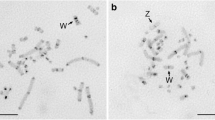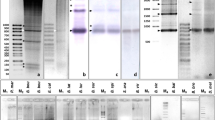Abstract
Two different types of novel satellite DNA (stDNA) sequences were cloned from the lesser rhea (Ptercnemia pennata) and the greater rhea (Rhea americana) after digestion of genomic DNAs with a restriction endonuclease Pvu II, and characterized by filter hybridization and in-situ hybridization to metaphase chromosomes. These nucleotide sequences consisted of GC-rich 288-bp and 332-bp repeated elements in P. pennata and 288-bp and 336-bp repeated elements in R. americana, all of which were organized in tandem arrays in the genome. The 288-bp and 332-bp elements of P. pennata displayed strong sequence similarity with the 288-bp and 336-bp elements of R. americana, respectively. The 332-bp and 336-bp elements were located on almost all the microchromosomes in both the species. The other type of repeated elements, the 288-bp element, was located on four and nine pairs of microchromosomes in P. pennata and R. americana, respectively. All the stDNA sequences were not crosshybridized to genomic DNAs of another three ratite species, ostrich (Struthio camelus), cassowary (Casuarius casuarius) and emu (Dromaius novaehollandiae), suggesting that these stDNA sequences are conserved in the same family but fairly divergent among the different families of Struthioniformes.
Similar content being viewed by others
References
Ansari HA, Takagi N, Sasaki M (1988) Morphological differentiation of sex chromosomes in three species of ratite birds. Cytogenet Cell Genet 47: 185-188.
Benirschke RJ, Sekulovich RE, Risser AC (1976) The chromosomes of Darwin's rhea (Pterocnemia p. pennata, Aves). Chrom Inform Serv 21: 13-14.
Chen Z-Q, Lin CC, Hodgetts RB (1989) Cloning and characterization of a tandemly repeated DNA sequence in the crane family (Gruidae). Genome 32: 646-654.
de Boer LEM (1980) Do the chromosomes of the kiwi provide evidence for a monophyletic origin of the ratites? Nature 287: 84-85.
Habermann FA, Cremer M, Walter J et al. (2001) Arrangements of macro-and microchromosomes in chicken cells. Chromosomes Res 9: 569-584.
Longmire JL, Lewis AK, Brown NC et al. (1988) Isolation and molecular characterization of a highly polymorphic centromeric tandem repeat in the family Falconidae. Genomics 2: 14-24.
Madsen CS, Brooks JE, de Kloet E, de Kloet SR (1994) Sequence conservation of an avian centromeric repeated DNA component. Genome 37: 351-355.
Matsuda Y, Chapman VM (1995) Application of fluorescence in situ hybridization in genome analysis of the mouse. Electrophoresis 16: 261-272.
Matzke MA, Varga F, Berger H et al. (1990) A 41-42 bp tandemly repeated sequence isolated from nuclear envelopes of chicken erythrocytes is located predominantly on microchromosomes. Chromosoma 99: 131-137.
Matzke AJM, Varga F, Gruendler P et al. (1992) Characterization of a new repetitive sequence that is enriched on microchromosomes of turkey. Chromosoma 102: 9-14.
McQueen HA, Fantes J, Cross SH, Clark VH, Archibald AL, Bird AP (1996) CpG islands of chicken are concentrated on microchromosomes. Nature Genet 12: 321-324.
McQueen HA, Siriaco G, Bird AP (1998) Chicken microchromosomes are hyperacetylated, early replicating, and gene rich. Genome Res 8: 621-630.
Nishida-Umehara C, Fujiwara A, Ogawa A, Mizuno S, Abe S, Yoshida MC (1999) Differentiation of Z and W chromosomes revealed by replication banding and FISH mapping of sex-chromosome-linked DNA markers in the cassowary (Aves, Ratitae). Chromosome Res 7: 635-640.
Ogawa A, Murata K, Mizuno S (1998) The location of Z-and W-linked marker genes and sequence on the homomorphic sex chromosomes of the ostrich and the emu. Proc Natl Acad Sci USA 95: 4415-4418.
Primmer CR, Raudsepp T, Chowdhary BP, Moller AP, Ellegren H (1997) Low frequency of microsatellite in the avian genome. Genome Res 7: 471-482.
Saifitdinova AF, Derjusheva SE, Malykh AG, Zhurov VG, Andreeva TF, Gaginskaya ER (2001) Centromeric tandem repeat from the chaffinch genome: Isolation and molecular characterization. Genome 44: 96-103.
Sambrook J, Fritsch FE, Manlatls T (1989) Molecular Cloning: A Laboratory Manual, 2nd edn. New York: Cold Spring Harbor Laboratory Press.
Schmid M, Enderle E, Schindeler D, Schempp W (1989) Chromosome banding and DNA replication patterns in bird karyotypes. Cytogenet Cell Genet 52: 139-146.
Sibley CG, Ahlquist JE (1990) Phylogeny and Classification of Birds: A Study in Molecular Evolution. New Haven: Yale University Press.
Silbley CG, Monroe Jr BL (1990) Distribution and Taxonomy of Birds of the World. New Haven: Yale University Press.
Singer MF (1982) Highly repeated sequences in mammalian genomes. Int Rev Cytol 76: 67-112.
Solovei IV, Joffe BI, Gaginskaya ER, Macgregor HC (1996) Transcription on lampbrush chromosomes of a centromerically localized highly repeated DNA in pigeon (Columba) relates to sequence arrangement. Chromosome Res 4: 588-603.
Stock AD, Arrighi FE, Stefos K (1974) Chromosome homology in birds: banding patterns of the chromosomes of the domestic chicken, ring-necked dove, and domestic pigeon. Cytogenet Cell Genet 13: 410-418.
Suzuki T, Kurosaki T, Shimada K et al. (1999a) Cytogenetic mapping of 31 functional genes on chicken chromosomes by direct R-banding FISH. Cytogenet Cell Genet 87: 32-40.
Suzuki T, Kurosaki T, Agata K et al. (1999b) Cytogenetic assignment of 29 functional genes to chicken microchromosomes by FISH. Cytogenet Cell Genet 87: 233-237.
Takagi N, Sasaki M (1974) A phylogenetic study of bird karyotypes. Chromosoma 46: 91-120.
Takagi N, Itoh M, Sasaki M (1972) Chromosome studies in four species of Ratitae (Aves). Chromosoma 36: 281-291.
Tanaka K, Suzuki T, Nojiri T, Yamagata T, Namikawa T, Matsuda Y (2000) Characterization and chromosomal distribution of a novel satellite DNA sequence of Japanese quail (Coturnix coturnix japonica). J Hered 91: 412-415.
Author information
Authors and Affiliations
Rights and permissions
About this article
Cite this article
Yamada, K., Nishida-Umehara, C. & Matsuda, Y. Characterization and chromosomal distribution of novel satellite DNA sequences of the lesser rhea (Pterocnemia pennata) and the greater rhea (Rhea americana). Chromosome Res 10, 513–523 (2002). https://doi.org/10.1023/A:1020996431588
Issue Date:
DOI: https://doi.org/10.1023/A:1020996431588




